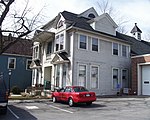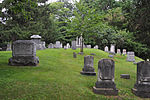Simeon Sage House
1830 establishments in New York (state)Houses completed in 1830Houses in Monroe County, New YorkHouses on the National Register of Historic Places in New York (state)Monroe County, New York Registered Historic Place stubs ... and 1 more
National Register of Historic Places in Monroe County, New York

Simeon Sage House is a historic home located at Scottsville in Monroe County, New York. It was built about 1830 and consists of a 1-story, five-by-two-bay, rectangular main block with a smaller 1-story rectangular rear wing in a vernacular Federal style. There are later Greek Revival style modification. It is an example of a working man's cottage. It serves as home to the Wheatland Historical Association and a rectangular, frame educational facility and meeting room were added in 2000.It was listed on the National Register of Historic Places in 2010.
Excerpt from the Wikipedia article Simeon Sage House (License: CC BY-SA 3.0, Authors, Images).Simeon Sage House
Main Street, Town of Wheatland
Geographical coordinates (GPS) Address Nearby Places Show on map
Geographical coordinates (GPS)
| Latitude | Longitude |
|---|---|
| N 43.019269444444 ° | E -77.756580555556 ° |
Address
Main Street 69
14546 Town of Wheatland
New York, United States
Open on Google Maps










